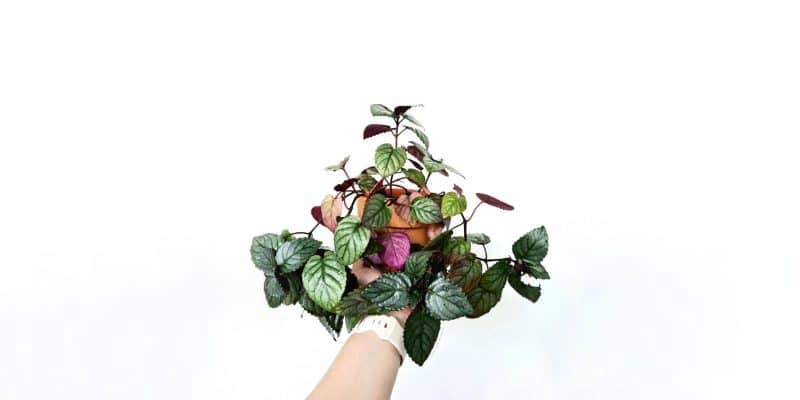The Purple Waffle plant, with its wild puckered metallic purple and green leaves, is an eye-catcher! Plus, it looks great in a hanging basket.
Added bonus: growing a Purple Waffle plant indoors means annual vivid hues, since this shiny gem is a perennial.
(You read me right: All that color, year after year!).
How can you successfully bring one into your own space? We’ll give you the scoop on everything you need to know about Purple Waffle plant care, including just how much light and water it needs and how to make new ones.
Table of Contents
Purple Waffle Plant Care Guide
History, Habitat, and Characteristics
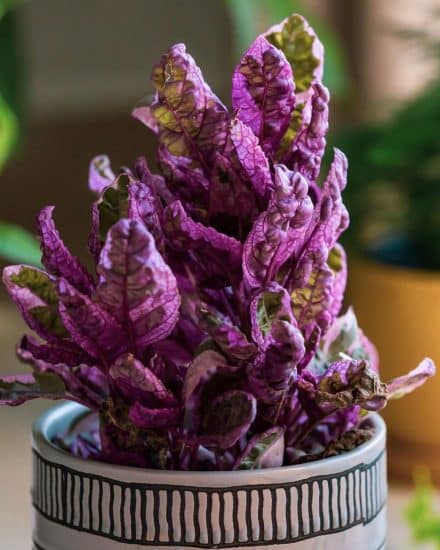
Native to Malaysia and Indonesia, the Purple Waffle plant (Hemigraphis alternata ‘Exotica’), is known for its distinctive foliage and easygoing nature. It’s also sometimes termed Strobilanthes alternata ‘Exotica’ (same plant, different Greek), Red Ivy, Red Flame Ivy, and Cemetery Plant.
The plant’s crinkly leaves definitely take center stage as they flaunt a blend of green and deep purple, creating an eye-catching waffled pattern. But there’s more — this charmer even has adorable, inconspicuous flowers that pop up occasionally to surprise you.
With its compact size of just 6 to 8 inches tall, the Purple Waffle plant is perfect for hanging baskets or tabletop displays. And here’s the kicker: it’s a breeze to care for, making it a real winner for gardening pros and novices alike.
Fun fact: The Purple Waffle plant belongs to the Acanthaceae family, which boasts a whopping 2,500 species, including the also purple Persian Shield!
If you’re growing Purple Waffle plant outdoors, note that its metallic sheen may not completely develop in full sun.
Light
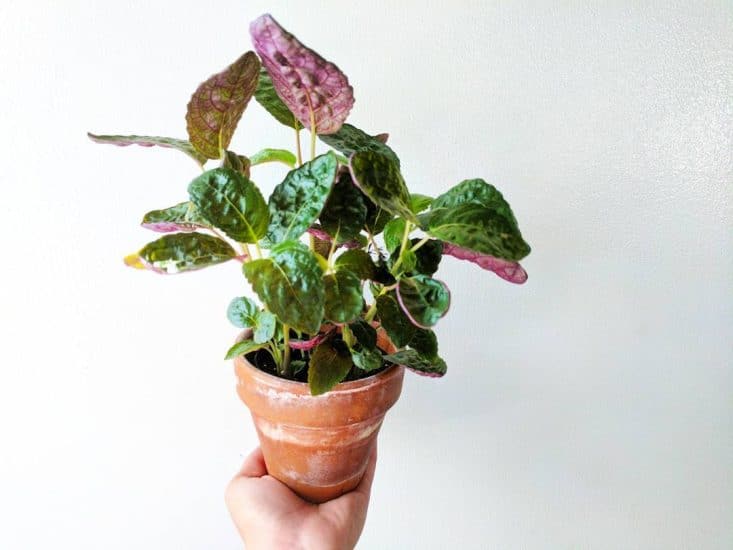
Purple Waffle plants, also known as Hemigraphis alternata or Belgian waffle plant, love their light! These houseplants can handle some direct sun during winter, but they’ll be happiest with indirect light during the other seasons.
A daily dose of 6+ hours of light (indirect) helps maintain their purple and green colors, along with their distinct purple undersides. During the summer, it’s even okay to keep them in partial shade.
However, if you notice that the colors of your Purple Waffle plant are fading, or if it’s growing leggy and slow, that’s a sign it’s not getting enough light. Leggy growth is a spreading growth habit, demonstrating that your Purple Waffle plant is trying to stretch out to catch any available light.
To solve this, move it to a brighter spot or add some artificial light, like an LED full-spectrum bulb.
On the other hand, if you see too much direct sun causing problems, the leaves might look sun-bleached or have small holes. If you notice any of these issues, simply place a sheer curtain between the plant and the window or move it further away.
Lighting tips:
- In winter, your Purple Waffle plant can enjoy some direct sun, but in other seasons, try to provide bright filtered light.
- Strive for 6+ hours of indirect light daily to keep those vibrant colors popping.
- Watch for fading colors and slow, leggy growth — signs that your plant needs more light.
- When leaves start looking sun-bleached or develop small holes, it’s time to move the plant or use a sheer curtain to shield it from intense sunlight.
Water
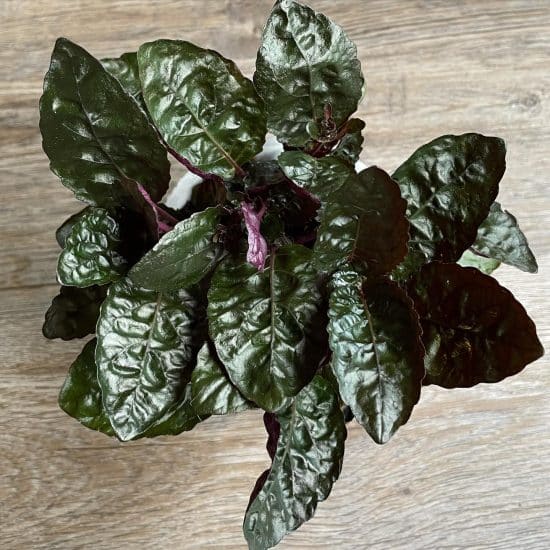
Your Purple Waffle plant, also called metal leaf plant, craves moist soil that isn’t too wet. This plant is prone to root rot, so aim for evenly watered soil, use filtered water, and don’t let the potted plant sit in water.
When your Purple Waffle plant is not getting enough water, its leaves will look droopy and wilted. (It gets pretty dramatic-looking at this point and may even make you fear for its life, but the waffle plant is a trickster that perks up very quickly after you give it that missing H20).
Brown tips or curling may also occur. If you spot these signs, adjust your watering schedule to maintain consistent moisture, without letting the soil get soggy.
On the other hand, too much water can result in yellow leaves, soggy soil, and dreaded root rot for Hemigraphis alternata. If you suspect your Purple Waffle Plant watering is going overboard, ease up and allow the soil to dry up before you water again. And don’t forget to ensure your pot has proper drainage holes to avoid soggy roots.
Our watering tips:
- Stick to filtered water at room temperature, which is gentle on your Purple Waffle plant and avoids shocking it with extreme temps or harsh chemicals.
- Keep an eye on those leaves! Droopy or wilted Purple Waffle plant leaves signal a need to increase your watering frequency.
- Test the soil moisture by poking a finger 1 to 2 inches into the soil. It should feel moist but not waterlogged, like a wrung-out sponge.
- Double-check your pot’s drainage holes; they’re essential for avoiding root rot and other issues related to overwatering.
- If you spot yellow Purple Waffle plant leaves or soggy soil, it’s time to cut back on watering and ensure proper drainage in the pot.
Temperature and Humidity
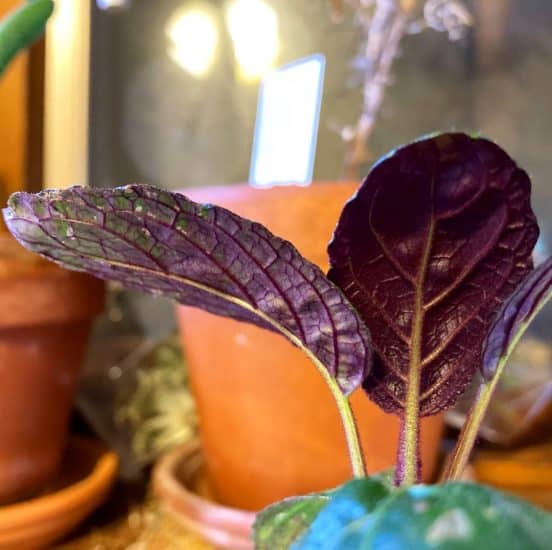
The optimum temperature for the Purple Waffle plant is between 55-75 °F. Although it is a perennial plant in warm temperatures like tropical Zones 10 and 11, it’s not a perennial in colder areas like Zone 3.
Keep your Purple Waffle plant away from cold drafts and windows, as temperatures below 50°F can cause stress to the plant. If you notice your plant’s leaves wilting or looking unhealthy, it might be time to check the temperature and make necessary adjustments.
As for optimal humidity, the purple waffle plant doesn’t require added humidity, but will thrive in a more humid environment. A well-lit bathroom can be an ideal spot for this tropical plant, as the humidity from showers and baths will help create a suitable environment.
If you aren’t able to place your Purple Waffle plant in a bathroom, you can still provide adequate humidity by placing a tray of water and pebbles beneath the plant or by using a humidifier.
Watch for signs of your Purple Waffle plant receiving too much or too little humidity. Too little humidity may cause browning on leaf tips or edges, while too much humidity could lead to mold or decaying leaves issues.
Soil and Planting
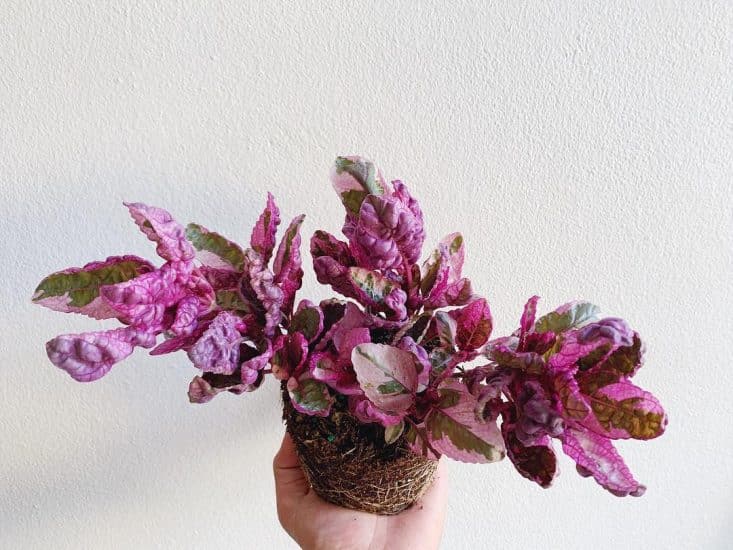
Purple Waffle plants love moisture-retentive, organic soil with plenty of humus materials. Incorporate perlite or vermiculite to ensure sufficient oxygen and prevent soggy roots. A rich, organic potting soil with more peat moss is ideal to ensure water retention without holding excess water.
The right Purple Waffle plant soil composition is essential for it to thrive. Signs of inadequate soil include slow growth rate, yellowing leaves, and weak stems.
A potting soil mix that’s too dense, lacks well-drained soil and sufficient aeration, or retains too much water can lead to root rot and other diseases, ultimately affecting the overall health of your Purple Waffle plant.
Fertilizer
Fertilize with a light, slow-release plant fertilizer during the growing season (spring and summer) at half the recommended strength. Too much fertilizer can cause scorched leaf tips, wilting, yellowing leaves, or leaves to fall off.
If you suspect over-fertilization, flush the soil with water to remove excess fertilizer salts and reduce future fertilizer applications. Always follow the recommended fertilizer dosage, and cease fertilizing during the dormant winter months.
Propagation
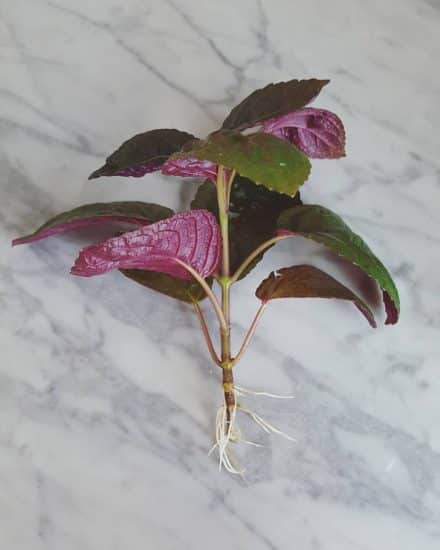
Ready to learn how to propagate Purple Waffle plants? You can do it by stem cuttings or by suckers (division).
Propagating Purple Waffle plants by stem cuttings or suckers:
- Preparation: Start by grabbing a clean pair of pruning shears or scissors, a small container to hold water, and a healthy and happy potted Purple Waffle plant. Remember to give your cutting tools a good clean to avoid spreading any pesky diseases.
- Pick a stem: Look for a vibrant stem on your Purple Waffle plant that’s practically begging to be propagated. Choose a healthy one with at least 3-4 leaves, and snip a 4-6 inch section, ideally just below a leaf node. It should have a couple of healthy leaves on top. If you’re going with the sucker technique, gently pluck them from the leaf nodes.
- Prep the cutting: Take off any leaves from the bottom nodes of your stem cutting. You want your Purple Waffle plant cutting to focus on growing some killer roots, and you don’t want any leaves rotting in the water. If you’re using suckers, they’re already good to go.
- H2O: Fill a small container with clean, filtered water, and plop your Purple Waffle plant stem cutting or sucker right in. Find a cozy spot with enough filtered light, and change the water every 2-3 days.
- Root watch: After a few weeks, you should see some roots form on your little cutting. When they’re reaching out about 2 inches long, it’s time for a new home. Pop your cutting into a pot filled with well-draining potting mix and drainage holes, bury those roots, and give your new Purple Waffle plant baby consistently moist soil.
Common Issues
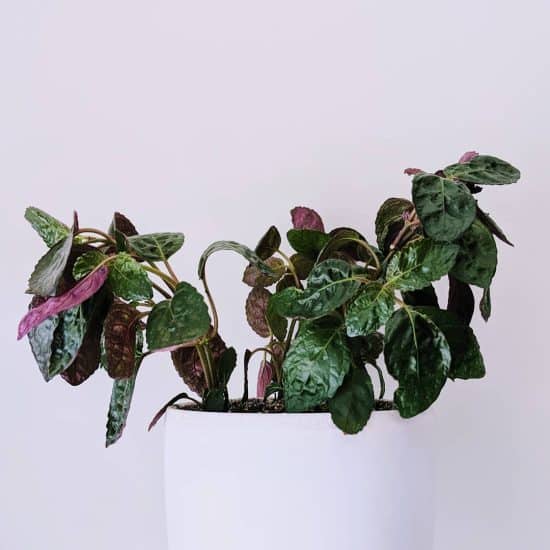
Drooping Leaves
This is often a sign that your Purple Waffle plant, or metal leaf plant, isn’t getting enough water. When the plant goes thirsty for too long, its leaves begin to droop, giving it a sad, wilted look. If this keeps happening, the leaves might even turn brown, and your Purple Waffle plant could reach a point of no return (nooo!).
To help your plant perk up, first, make sure you’re giving it enough water. Check the top couple of inches of the fresh soil — if it feels dry, it’s time to give your Purple Waffle plant a good drink. And when I say “good drink,” I mean allow the water to drain from the bottom of the pot.
This well-drained soil will help keep the roots hydrated and avoid future wilting. Trust me, your plant will thank you!
Yellowing Leaves
Yellow leaves could be due to a few things, like too much sunlight, overwatering, or even giving your Purple Waffle plant too much plant fertilizer (yep, there is such a thing as too much love!).
To rule things out, let’s take a look at the plant’s spot within your home. Is it getting ample bright indirect light? Direct sunlight can scorch the leaf surface, causing them to go yellow.
If adjusting the light doesn’t do the trick, let’s look at water and fertilizers. Overwatering can lead to yellow leaves, so make sure you’re letting the soil dry out between waterings and check for proper drainage.
As for fertilizing, make sure you’re using slow-release fertilizers — nothing more, nothing less. By paying attention to these factors, you’ll help your Purple Waffle plant stay happy and healthy.
Pests and Diseases
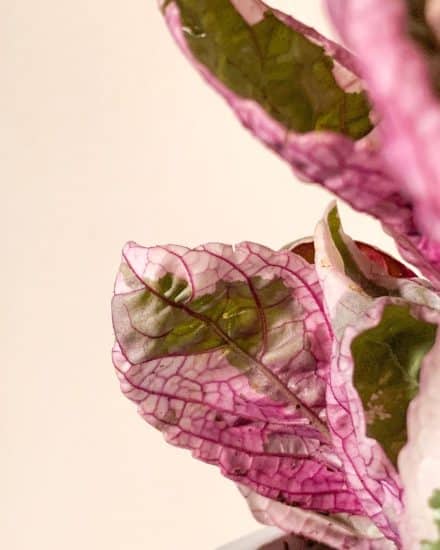
Scale Insects
These tiny troublemakers are round, hard-shelled, little critters that can sneakily sap the life out of your healthy Purple Waffle plants. They come in various shades like brown, black, or even white. Here’s the tricky part — they’re pretty good at camouflaging themselves on your plant!
First, take a closer look at the stems and undersides of your plant’s leaves. If you find sticky residue (also known as honeydew) or notice your plant looking sad, chances are you’ve got a scale insect problem.
To tackle a small infestation, all you need is a damp cloth or cotton swab dipped in rubbing alcohol. Gently wipe your plant’s leaves and stems to remove the pesky critters.
But for more widespread invasions, you might want to bring in the big guns: horticultural oil or insecticidal soap. Make sure to follow the product label’s instructions for the best results.
Inspect your plant regularly for signs of scale insects. Monitoring your purple waffle plant’s water, light, and nutrients will make it much less likely to fall prey. Oh, and for preventative measures, you can give your plant the occasional treatment of a systemic insecticide.
Whiteflies
These minuscule moths (which aren’t technically flies) are a potential headache for your Purple Waffle plant. They might be tiny, but their appetite for sap is anything but small. So, let’s learn how to keep these little plant-pickers at bay, shall we?
If you happen to see tiny white bugs fluttering about your plant or notice leaves turning yellow, don’t panic. It’s time for a whitefly inspection. Don’t forget to also check for sticky leaves or the dreaded sooty mold — both signs of honeydew.
First things first: isolate your affected plant from its leafy neighbors to prevent spreading further insect invasions. Then, carefully remove and discard any seriously infested leaves. Grab yourself some insecticidal soap or horticultural oil and give the affected areas of your plant a good spray. (Always read and follow the label directions).
Conclusion
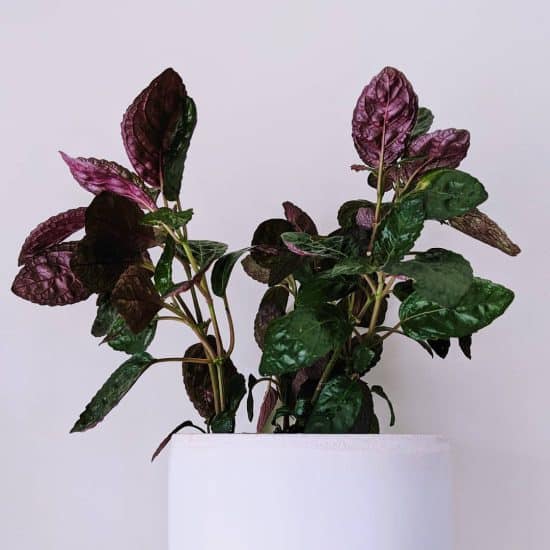
That’s all for our Purple Waffle plant care guide! By now, you should be well-equipped with the knowledge and confidence to welcome this captivating beauty into your home and provide it with the optimal care it deserves.
Purple Waffle Plant care summary:
- Ensure your plant receives 6+ hours of bright, indirect light daily for vibrant foliage color.
- Create a comfortable environment with temperatures between 55-75°F and adequate humidity.
- Use a well-draining, moisture-retentive, organic potting soil with added perlite or vermiculite.
- Fertilize lightly during the growing season (spring and summer) and propagate via stem cuttings or suckers.
- Keep an eye on common pests like scale insects and whiteflies, and manage them effectively to keep your plant healthy.
We hope our Purple Waffle plant care guide has been helpful and answers all your questions. If you’ve found this guide useful, feel free to share it with fellow plant lovers! Should any concerns arise that we haven’t covered, don’t hesitate to reach out and ask.
Happy gardening, and embrace the colorful wonder that is the Purple Waffle plant!
FAQ
Are Purple Waffle plants rare?
Purple Waffle plants (Hemigraphis alternata) might seem like a rare gem with their enchanting blend of green and deep purple crinkly leaves, but they’re not that rare after all! You can easily bring home one of these captivating beauties without embarking on a challenging treasure hunt.
Should you mist a Purple Waffle plant?
We recommend not misting these plants. Although they do prefer high humidity, frequent misting can lead to issues such as mold and mildew growth, as well as an increased risk of some pests. Instead, increase humidity by placing them on a plant pebble tray or by using a humidifier.
Is the Purple Waffle plant a perennial?
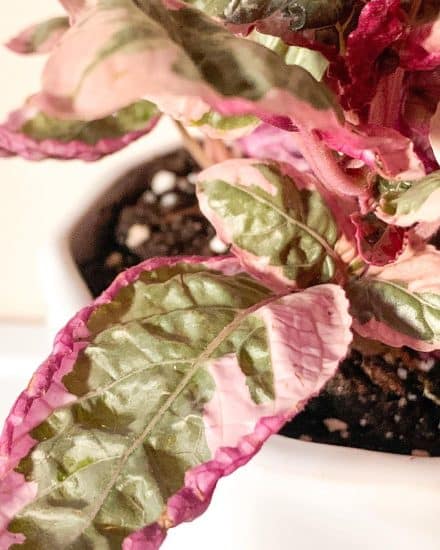
Purple Waffle plants are perennial houseplants and will keep their leaves all year round. Rest assured that once you’ve welcomed this plant into your home, you’ll enjoy the enchanting beauty of its foliage for a very long time.
Is the Purple Waffle plant toxic?
Nope! This one is nontoxic, so it’s safe around curious kids and critters. However, we still recommend keeping it out of reach of any potential chewers, since plant material not intended for ingestion can still potentially cause harm.

